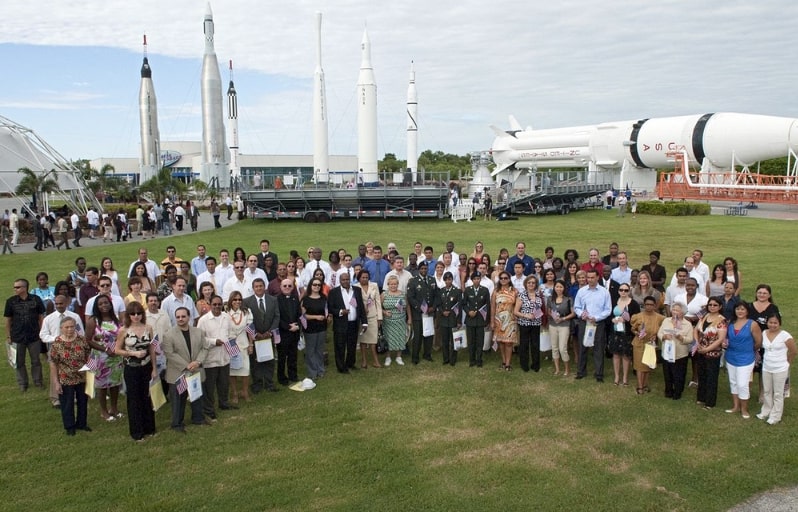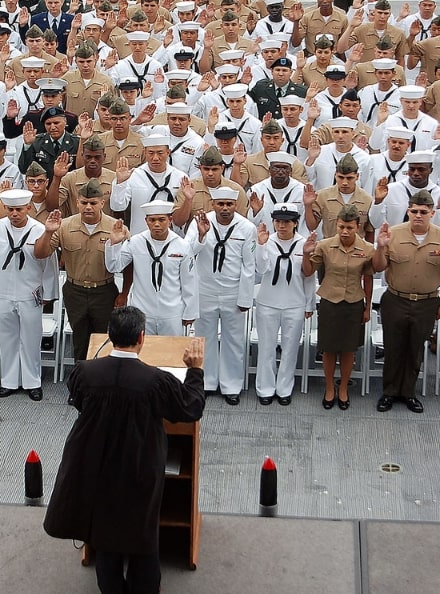Introduction: In this article, Katie Rebecca Garner gives tips for finding records and learning the stories about your immigrant ancestors when they became naturalized U.S. citizens. Katie specializes in U.S. research for family history, enjoys writing and researching, and is developing curricula for teaching children genealogy.
Except for Native Americans, citizens born in the U.S. are descended from immigrant ancestors. A child born in the U.S., whether born to U.S. citizen parents or to immigrant parents, is born a U.S. citizen.
An immigrant only becomes a citizen by a process called naturalization. If your immigrant ancestor naturalized, their naturalization records can reveal information about their family and immigration history.

About Naturalization
Immigrants to the U.S. have never been required to naturalize; however, naturalization grants citizenship and all associated privileges including voting and owning land. There has always been a residency requirement before an immigrant could naturalize. For most of U.S. history, this was five years.
The first step of naturalization is to file a declaration of intent, or the first papers. The next step is to file a petition for naturalization, or the second papers. Once the petition is accepted, the immigrant is granted a certificate of naturalization. Sometimes several years pass between the filing of the first and second papers. Sometimes an immigrant moved during that process, resulting in each of the papers being filed with a different court. Sometimes an immigrant ancestor started the process but never completed it.
For immigrants who served in the military, this process was simplified. In most cases, only the petition for naturalization was required and the required residency time was reduced to one year.
History of Naturalization in the U.S.
Before the Revolutionary War, British settlers in the colonies had no need to naturalize because they were still in British territory. Settlers from other countries had to naturalize if they wanted the privileges of British citizenship. At this time, there were different levels of naturalization available, including denization which granted the right to own land but not the right to vote.
Until 1906, each individual court had their own naturalization form, each capturing what they thought pertinent. This means there is no consistency of information in pre-1906 naturalization records. Some courts recorded more details in the first papers while others recorded more details in the second papers. Therefore, it is advisable to obtain both papers for ancestors who naturalized before 1906.
In 1906, the Bureau of Immigration and Naturalization was created. This resulted in standardized forms across the country. Naturalization still occurred in local courts, but they sent a copy of the forms to the Bureau of immigration and Naturalization.

Sometimes an act of congress would collectively naturalize a mass of people, negating the need for them to file individual paperwork. This happened with major historical events such as the U.S. becoming its own nation, and the Civil War. In these respective cases, all colonists and all former slaves became U.S. citizens. This also happened with the expansion of the U.S. With the Louisiana Purchase, or the annexation of Texas or other additions of territory, residents of those territories became U.S. citizens.
Up until 1922, a woman’s citizenship depended on that of her husband. If a U.S. citizen woman married a man who was an alien, she lost her citizenship. If a married man naturalized, his wife also gained citizenship. This ended in 1922 when an act was passed giving women independent citizenship. If your ancestors naturalized after 1922, there will be separate records for the men and the women.
Finding Naturalization Records
The first step in finding naturalization records is to have an idea of when and where the ancestor may have naturalized. If the ancestor lived during the 19th century, the 1820, 1830, 1840, and 1870 censuses state if the ancestor was an alien or citizen. If the ancestor lived during the 20th century, those censuses give more specific clues to immigration and naturalization. The 1920 census includes the years of immigration and naturalization.
Before looking for naturalization records, it is helpful to know where the immigrant ancestral family lived since arriving in the U.S. Federal and state censuses, tax lists, land records, and city directories can provide a paper trail showing where the ancestral family has lived. Check the local courts of every area where the ancestor lived for their naturalization records.
The Family History Library and National Archives contain naturalization and citizenship records. The FamilySearch wiki contains a list of resources kept at the state level; to find naturalization records for the state your ancestor lived in, check the wiki page for that state(s). Remember that not all records are online, so it may be necessary to contact the court where the naturalization may have occurred to request records.
Often, naturalization records provide clues about your ancestor’s immigration, which can be helpful in finding the immigration records. For example, this was the case with Joseph McElhinney, who arrived in America in 1909. When he registered for the WWI draft in 1917, he was an alien, not having yet naturalized. (1) He was an alien on the 1920 census, but a naturalized citizen on the 1930 census; this indicates that he naturalized in the 1920s. In fact, Joseph McElhinney naturalized in Pennsylvania in 1921. His naturalization records indicate that he arrived in New York on 28 March 1909 on the Caledonia, and had left from Londonderry, Ireland. (2) The records also give his occupation, and list his wife and children along with their birthdates. (3) Had he naturalized a year later, his wife would have had to naturalize separately.
Who were your immigrant ancestors? Did they naturalize? If they did, look for their records and see what you can learn about them.
Explore over 330 years of newspapers and historical records in GenealogyBank. Discover your family story! Start a 7-Day Free Trial
Note on the header image: a man taking the required citizenship oath of allegiance in front of a U.S. government official in New York City, 8 February 1910. Credit: Library of Congress, Prints and Photographs Division.
Resources:
- https://www.familysearch.org/wiki/en/United_States_Naturalization_and_Citizenship
- https://www.familysearch.org/wiki/en/U.S._Naturalization_Records_Class_Handout
Related Article:
_________________
(1) “United States World War I Draft Registration Cards, 1917-1918,” database with images, FamilySearch (https://www.familysearch.org/ark:/61903/1:1:K6KQ-4NQ: 25 December 2021), Joseph McElhinney, 1917-1918.
(2) “Pennsylvania, Eastern District Petitions for Naturalization, 1795-1931,” database with images, FamilySearch (https://familysearch.org/ark:/61903/1:1:QGJQ-3DNQ: 8 March 2021), Joseph McElhinney, 17 Aug. 1917; citing Naturalization, Pennsylvania, United States, NARA microfilm publication M1522 (Washington, D.C.: National Archives and Records Administration, n.d.); FHL microfilm.
(3) “Pennsylvania, Eastern District Petitions for Naturalization, 1795-1931,” database with images, FamilySearch (https://familysearch.org/ark:/61903/1:1:QGJQ-3DNW: 8 March 2021), Joseph McElhinney, 3 March 1921; citing Naturalization, Pennsylvania, United States, NARA microfilm publication M1522 (Washington, D.C.: National Archives and Records Administration, n.d.); FHL microfilm.
